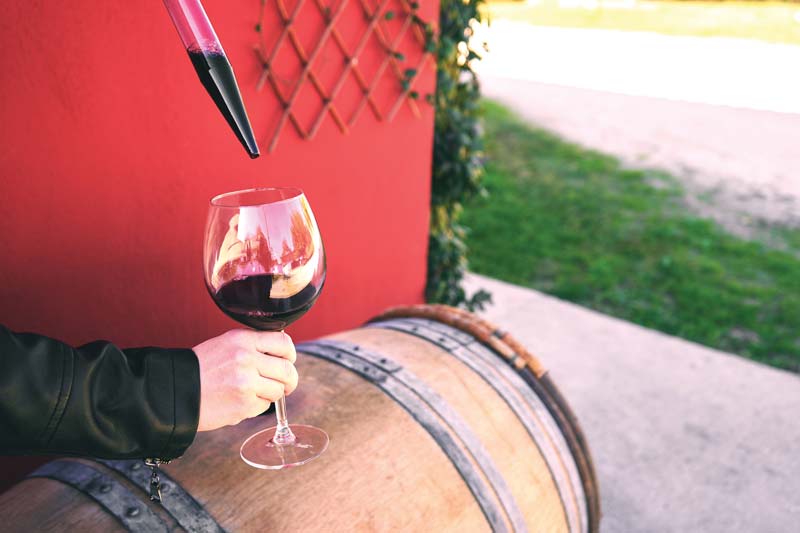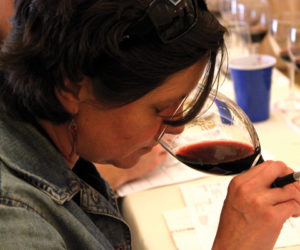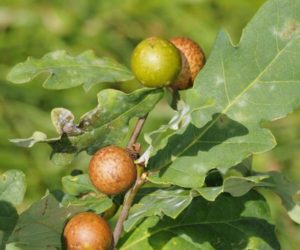Q Do you see any opportunities for new styles of wine made from smoke-tainted grapes? Have you tasted any commercial examples purposefully using smoke-tainted grapes?
Brian Cox
Martinez, California

A I’ve heard rumor that a couple of smaller wineries that have experienced smoke taint in their grapes are indeed evolving that wine into new styles. Depending on the grape type and level of impact, it’s possible their base wines may have a wide array of “smoke effect” descriptors like: Bacon-y, deli meat, barbecue, toasty, etc., which all can be positives in the right place. As long as a wine isn’t completely objectionable (think old ashtray or cigarette butt), it’s perfectly sensible to me to try to work with what you’ve got. In some cases, winemakers are layering on a lot of oak, or doing one of these Bourbon-barrel style wines, which lean heavy on the toasty oak and seek to make a feature of the smokiness, rather than perceive it as a flaw. How well are these wines selling and how consumers are perceiving them I couldn’t tell you as I don’t have any insight there; but I do know some folks are getting creative when they are working with grapes and wines with a somewhat smoky character.
In general, smoke taint is a new phenomenon as wildfires have really only been a part of winemaking in the past 5–10 years. The research on the subject is still fairly nascent and there is still so much we don’t know. For what it’s worth, I would like to tell our readers some basic facts about smoke taint in grapes and wines as well as some of my personal observations:
• Smoke-affected grapes and wines are still safe for human consumption.
• Many of the “smoky” compounds that can be signs of smoke exposure in grapes and wine are actually desirable in many wine styles. In fact, many are the exact same chemical components that winemakers purposefully put into wines in the form of toasted oak barrels, chips, beans, etc.
• Smoke-taint research is still in its infancy. Experts still disagree about which markers to use to track evidence of smoke taint, what level of smoke exposure is a risk, and even the definition of what smoke taint is.
• Just because there is smoke in the air doesn’t mean your grapes and wine will exhibit smoke taint in the finished wine.
Anecdotal evidence from my winemaking community includes:
• After about a year of age the wine will express whatever smoky characteristics it’s going to.
• Spending a lot of money to send wine and grape samples into fancy labs like ETS is practically meaningless as the numbers don’t seem to correlate well to actual aroma or flavor intensity of defects in the wine.
For more information about smoke taint in grapes and wine, I recommend visiting the Australian Wine Research Institute’s (AWRI) website.
There’s a lot more that I could write about the topic. But in the meantime, yes, feel free to experiment with some new wine styles if ever you are faced with a smoky vintage!
Q I’ve got a recipe that suggests I should crush and dissolve a Campden tablet and add it to the grape must (I’m planning on making a red wine from some spare Cabernet and Merlot I’ll be able to pick up from a friend this harvest) before fermentation. Won’t this kill off the yeast?
Bryan Derry
Prosser, Washington
A The great thing about Campden tablets (a convenient form of dosing in sulfur dioxide for home winemakers) is that they will inhibit the yeast and bacteria you do not want (which are sensitive to sulfur dioxide) while allowing the yeast you do want to continue to power through the fermentation.
Longtime readers of my column know that I almost always inoculate my wines with a commercial yeast strain (purchased from a reputable dealer) that is specifically chosen for my wine’s conditions. Since you’re doing a red wine in the Prosser area, I’ll figure you’ll be able to get your grapes plenty ripe . . . and that you’ll need a yeast strain that can tolerate a temperature up to about 95 °F (35 °C) and an alcohol up to 15%. This will provide the best chance at a complete fermentation.
One crushed Campden tablet in one gallon (3.8 L) of wine produces about 65 ppm (or mg/L) of total sulfur dioxide.
A purchased yeast is grown and formulated to tolerate a little bit of sulfur dioxide and I almost always add around 35-50 ppm total sulfur dioxide at the crush pad in order to inhibit ambient bacteria and to suppress “wild” yeast that could spoil an entire batch. By dosing your grapes with a little sulfur dioxide, you’re making sure your yeast will be able to power through your fermentation safely while “bad bugs” and their “bad behavior” will be repressed.
One crushed Campden tablet in one gallon (3.8 L) of wine produces about 65 ppm (or mg/L) of total sulfur dioxide. Since I’m not sure which recipe you’re referring to in your question I can’t quite tell you if one tablet is too much or not. Just be sure you don’t use more sulfur dioxide or Campden tablets than a recipe calls for. Measure twice, cut once, and ferment on!
Q Is there a website or another resource I can use to check to determine whether the growing conditions were favorable in a particular AVA before I buy grapes from that area?
Stephen Boyle
Colonia, New Jersey
A Sometimes local AVA (American Viticultural Area) groups will have data available on their websites or emails available to members (the latter is the case with, for example, Napa Valley Vintners). For the most part, however, home winemakers won’t be members of these kinds of groups (they can cost thousands of dollars to join) so they will have to seek out data independently.
Many viticulturalists and winemakers I know subscribe to newsletters and data services like those from Western Weather Group (westernweathergroup.com) or Weather Bell (weatherbell.com). You can look up forecasts for a given area, current conditions as well as browse searchable and downloadable historic data in order to get an idea of how an area is progressing. Sadly, these are not wine-specific in any way, though most will provide an agricultural-based data set like degree days from certain dates, etc., which can help predict when grapes will ripen.
This kind of forecasting and historical weather information isn’t free, however. For example, Weather Bell costs $270/year for a personal/non-professional subscription and $660/year for a professional/business subscription. It might be worth poking around the NOAA (National Oceanic and Atmospheric Administration) website at www.ncei.noaa.gov/cdo-web/ because it does seem to offer current and historical data and is searchable by state, county, or zip code. It’s a big clunky website, however, so it might take a little digging to find things that will be of specific interest to you. In the few minutes I spent on the website, I was able to find degree-day data as well as precipitation data for the Napa area over certain date ranges.
Numbers are only numbers, however. Actually getting in the vineyard and checking out the fruit and canopy, even two or three months before harvest, can give you a great idea about what the year has done so far. For example, this year, as I was touring our Russian River vineyards, I could visually see that in some cases the winter hail damage we had caused a lot of berries to not set, and the vines were setting a bunch of second crop. If you can possibly go to visit a vineyard yourself that’s always best, but if you can’t, if you’ve got connections in the area or if you can have the vineyard owner send you pictures or just talk you through what’s going on in an area, it all will help you to make a decision.
Q I really enjoy your column and have been a big fan over the years. I’ve even heard you speak at some of the WineMaker Conferences, which are always really fun. I love the way you put things and love your bits of “winemaking wiz-dom” that you share with us. Is there any way you could distill down for me some of your “pearls of wiz-dom” in one of your columns? It’d be fun to see what you think are some of the most important axioms of winemaking.
Stacy Beamer
San Carlos, California
A Thanks for your kind words! I always really enjoy the WineMaker Conferences and connecting with the readership — it helps me put names and faces to the invisible readership out there and I so much enjoy doing a little “Wine Wizard Live.” So, in an attempt to take up your challenge, here are some snippets of “Wiz-dom” (as you put it, lol) that I do seem to find myself repeating in the columns and in my talks . . . consider it a lovingly-edited “Best of” list from me to you!
Five Golden Rules of Winemaking
- Your wine is only as good as your starting material.
- Acid is the backbone of a wine.
- Learn the science behind the art.
- Listen to your wine. Let the wine tell you the path it needs to tread, don’t force it.
- Don’t take wine, or yourself, too seriously.
• The single most important decision a winemaker can make for a wine is when to pick or selecting raw material if you don’t buy grapes (but I assume many of you do).
• Timing of the harvest will guide you on the path to what the wine will (or won’t) become. This is already laid out before you. The key is knowing how to read which path to take.
Pressing: Press cuts — take them if you can!
Maceration: You get most of your color in five days anyway and I’m not sold on the benefits of an extended maceration, it really just increases your biogenic amines as well as ups your microbial load.
Keys to a Successful Fermentation
- Start with sanitation. Know the difference between cleaning and sanitizing. Cleaning is rote soil removal. Sanitizing is killing unwanted microbes after cleaning removes many of them. An effective sanitizing solution is the following:
3 g sulfite powder
12 g acid
1 gal. (3.8 L) water - You want happy yeast! Nutrition balance is key. If you can get your juice and must tested, shoot for 300 ppm YAN (yeast assimilable nitrogen) using a non-DAP containing yeast nutrient, and only add DAP in small amounts, and not after 5 °Brix.
- Acid adjustment. Do it as early as possible in the must/juice stage. Try to have reds finish out with a pH of 3.45–3.65, whites under 3.60. Be sure to have your wines go through malolactic fermentation unless you will filter and/or hold cold/bottle early.
- Air is your friend during fermentation. Yeast needs oxygen to build their cellular membranes.
- If you add copper, measure it! Don’t just use copper fittings.
- Try fermenting on oak! It can fix color, add sacrificial tannins, and start your wine off on the right footing.
Yeast Considerations
- Don’t overthink it.
- Go native only if conditions allow it.
- I use PDM except for QA23 for Chardonnay.
- If you have lots of separate containers and can predict what your conditions will be, it’s OK to use some fancy specific yeasts.
- A complete fermentation should be your goal. Dealing with a stuck fermentation is hard for home winemakers.
Proper Élevage
- A topped container is a happy container!
- Ullage management, volatile acidity (VA) management, film yeast management . . . these are all key to keeping spoilage microbes from invading and ruining your wine during aging.
- Air is good when you need to rack.
- Don’t let a nasty lees reduction layer accumulate at the bottom of your containers; it can cause H2S (hydrogen sulfide, i.e., rotten egg smell).
- Check free SO2 every month and after every big move.
- Ideally check VA every month when you check free SO2 — this helps you keep track of a wine’s microbial health.
Barrels and Oak Alternatives
- “Winemaker, step away from the barrel!” i.e., don’t over-oak your wine or attempt to hide flaws.
- A full barrel is a happy barrel. Keeping the barrel topped up will help ensure safe, well-aged wine with no oxidation or VA problems over its lifetime.
- Definitely consider the wonderful world of chips, barrel inserts, and staves. They’re ideal for small batches. Radoux, Barrel Mill, G3/Boise Vivelys are all good lines, but most coopers and oak companies will offer non-coopered oak.
Blending Advice
- Never blend a loser, i.e., don’t throw good wine after bad.
- Look for “what’s missing” and try to find wines to fill the slot.
- Don’t be afraid to try 0.5%–5% . . . a little of something can make a big difference.
- Trade wine to create blends with your winemaking friends or club members.
- Don’t be afraid to buy a commercial bottle of wine to get a few mLs to top up your carboy. It’s OK, I won’t tell anyone!
- Explore finishing tannins, arabinols — add sweetness and roundness with non-fermentable sugars.
Fining and Stability
- Time is the best fining agent.
- I don’t tend to fine my wine, especially with animal products. It often just isn’t necessary. My sole exception is for my whites: Bentonite and then use Celstab/CMC to avoid cold stabilization issues. It’s a game changer!
Top Rookie Mistakes
- Picking grapes too early or too late.
- Inappropriate must adjustment.
- Not understanding the destructive power of oxygen.
- Not understanding the constructive power of oxygen.
- Keeping inadequate records.
Most importantly: Keep good records, do your bench trials before making additions, and HAVE FUN!







